Introduction
- Globalization has changed the way organizations carry out their projects.
- Many organizational projects cover geographically diverse regions and involve people from different regions (Ortig & Buergi, 2006).
- To reduce costs as well as to take advantage of advanced technology, organizations have resorted to virtual teams to undertake projects.
- Virtual teams’ members may be located in different cities, countries and/or continents (Dalton, Ernst, Leslie & Deal, 2002).
- Managing a virtual team is a difficult task for project managers.
- Besides the lack of the human element (Hinds & Bailey, 2003), project managers as well as the team members have to deal with language barriers, differences in time zones, differences in culture and poor cooperation among other challenges.
- The purpose of this presentation is to propose ways in which a virtual team consisting of Indian and Japanese employees can be motivated. The main focus will be on improving communication between these two groups of workers.
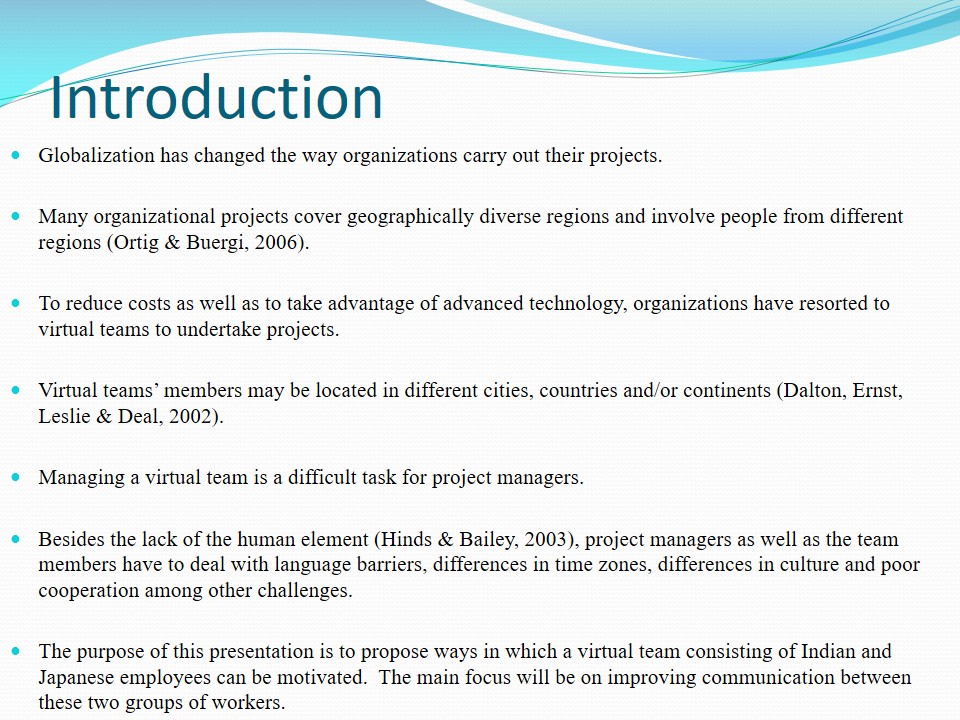
An Overview of Indian Culture
- In a nut shell, the Indian culture differs significantly from the Western culture.
- Indians have a strong feelings towards loyalty and prefer to develop long-term relationships rather than a short-term relationship (Sinha & Sinha, 1994; Bobby & Yohannan, 1992).
- The Indian society is thus a collectivist society with strong bonds between family and caste members as well as close friends (Gopalan & Dixon, 1996).
- Indians also value their spirituality and place less importance on material wealth. People work to satisfy their own and their families’ basic needs.
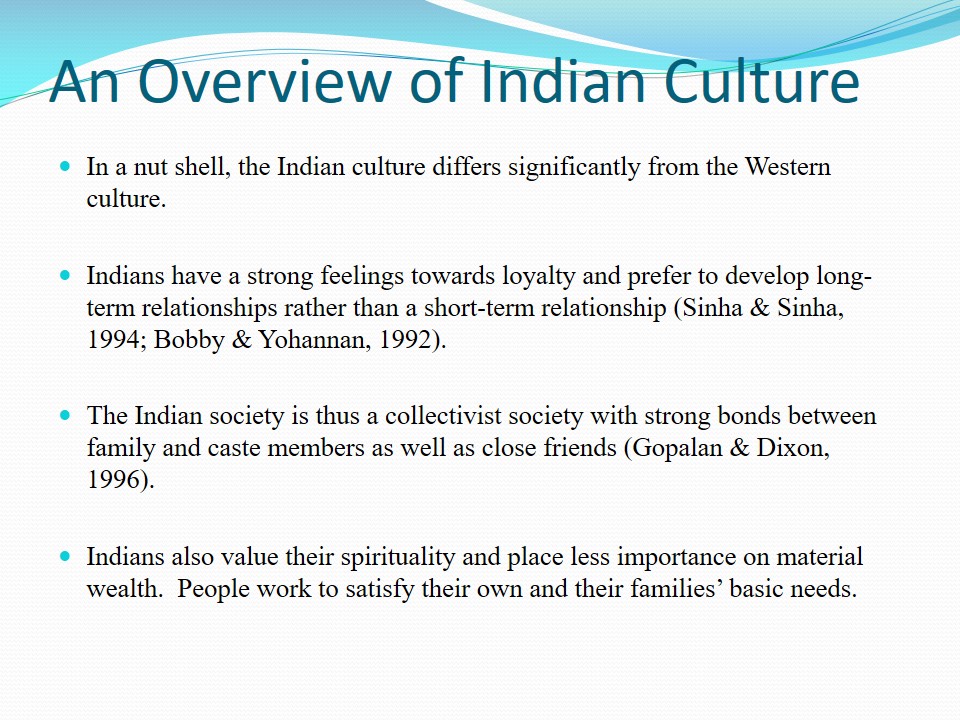
An Overview of Japanese Culture
- The Japanese culture is a high-context culture. One of the characteristics of a high-context culture is indirect and implicit communication, rather than direct and explicit. Japanese therefore approach conflicts in a discreet and subtle manner (Qingxue, 2003).
- Like their Indian counterparts, the Japanese society is also a collectivist society (Qingxue, 2003). The Japanese therefore place emphasis on the opinions, needs and goals of the family and community members rather than of oneself.
- Hierarchy is also important in the Japanese culture. Thus, people are aware of their duties and commitments to those who are older than them (Qingxue, 2003).
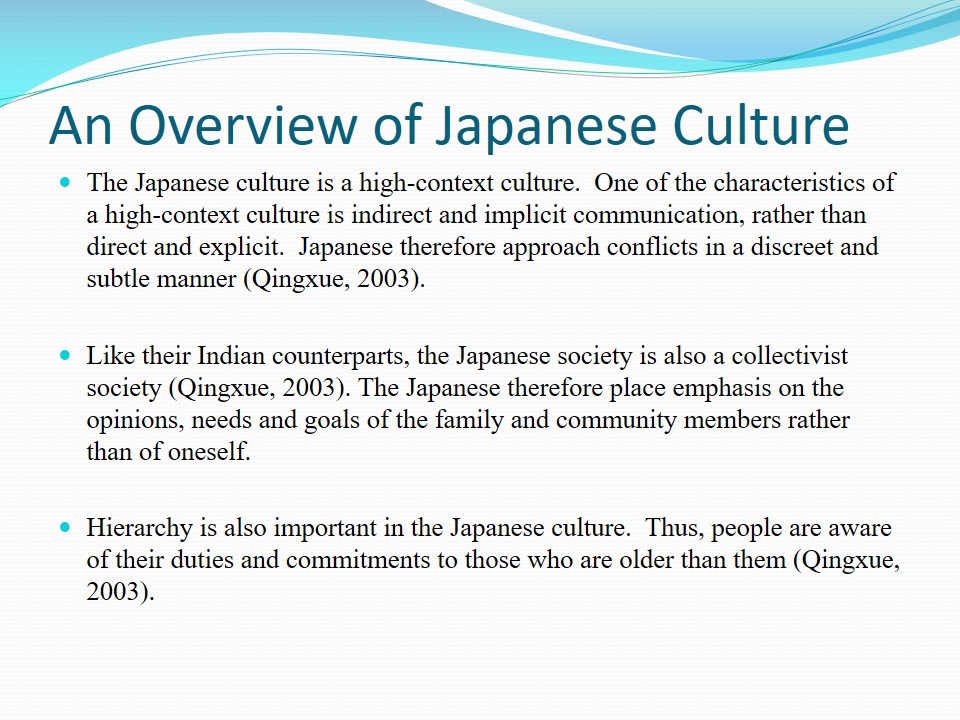
Ethical considerations
When dealing with cross-cultural communication, various ethical issues arise.
One ethical issue is the tendency of people to think of their culture as superior to the culture of other people. This is referred to as ethnocentricism (Ess, 2009). With regard to Japanese and Indians, although these two cultures share some similarities, they also differ in some aspects such as language and accent. It is therefore natural for a Japanese to criticize an Indian’s accent and vice versa.
Ess (2009) in recognition of these ethical issues argues that in order to become complete and content individuals, there is need for a range of virtues. He further argues that “these virtues are especially important if we are to move away from communication that focuses solely on our shared commonalities and identities to communication that enables us to develop deeper understanding of and respect for others” (p. 104).
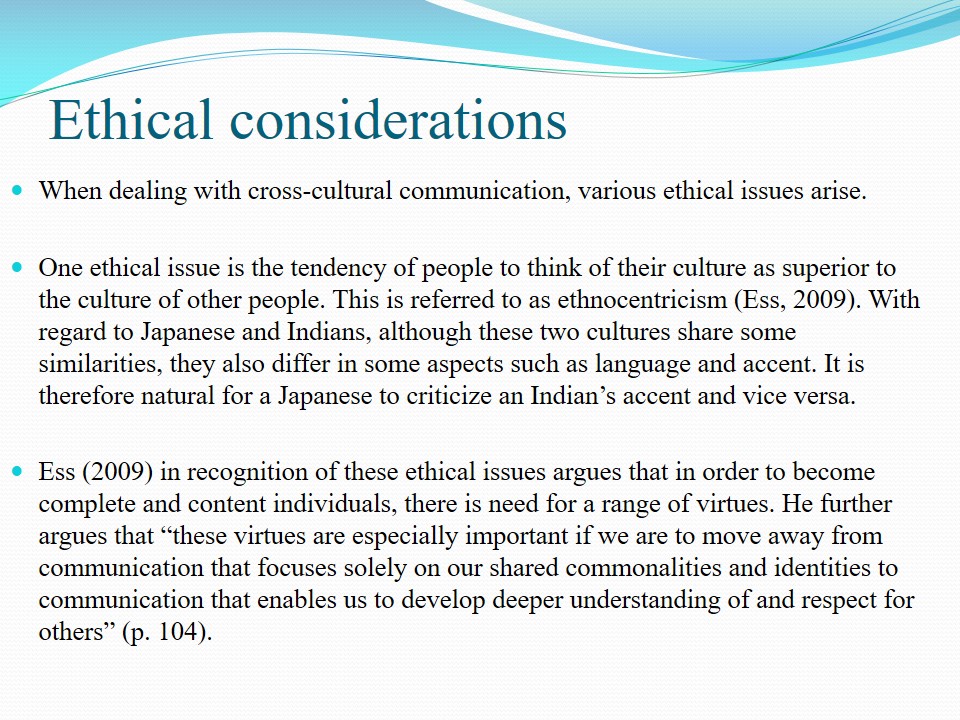
Critical thinking considerations
Besides ethical considerations, critical thinking considerations are also important in cross-cultural considerations.
Critical thinking is an important skill in the business world. It has been defined in several ways one of which is “active, persistent, and careful consideration of a belief or supposed form of knowledge in the light of the grounds which support it and the further conclusions to which it tends” (Fisher, 2001).
In cross-cultural communication, people already have pre-determined beliefs and ideas about other people from different cultures. Critical thinking improves cross-cultural communication because it enables people to think through and analyze issues without being influenced by prior judgment and opinions about people.
Critical thinking involves questioning the words and actions of others without putting prejudice in the picture.
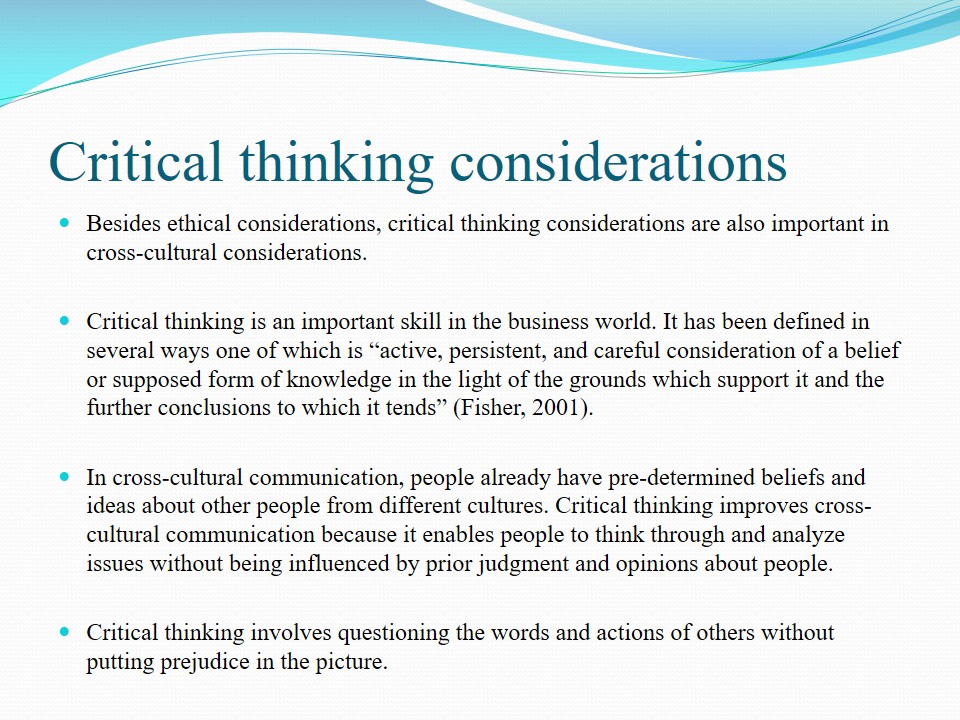
Motivating a Virtual Team of Indian and Japanese Employees
- Managing a cross-cultural virtual team requires special leadership and management styles. This is especially the case when it comes to enhancing communication among the team members (Iles & Hayers, 1997).
- Various strategies have been proposed by scholars and experts.
- This section addresses how a manager of a virtual team involving Japanese and Indian employees can motivate them and make them more productive. These suggestions are based on the cultural orientations of these two cultures.
Encouraging active participation of the members:
- A manager of the virtual team should pay close attention to how the Japanese and Indian employees carry out their functions.
- Because both of these groups of employees come from collectivist societies which focus on loyalty to others and respect to authority, there is a high tendency of reaching agreements prematurely and conforming to the group (referred to as groupthink).
- A leader should encourage the team members to be active participants in the team and to give their own opinions regarding any arising issue. Because this is a virtual team, this can easily be achieved by requesting each employee to write an email with their opinions whenever an issue arises (Schermerhorn & Bond, 1997).
The importance of human element:
- Members of a virtual team communicate mainly through telephones, internet and video conferencing.
- Given that Indians and Japanese value long-term relationships, the human face is an important element to them. Thus, face to face communication is more appreciated than communicating through devices (Vakola & Wilson, 2004).
- The project manager can motivate the team by organizing events such as workshops, seminars and weekend-offs probably twice or thrice a year. These events would enable the team members to meet each other face to face and to develop long-term relationships, which are very important to them.
Addressing language barriers:
- Although English is used as the official language of communication among the team members, there are language differences between the Indian and the Japanese team members.
- The language differences take the form of differences in the pace of speech, use of slang, and differences in accents (Schermerhorn & Bond, 1997). As a result, it was difficult for the team members to understand each other well especially if the communication was done through the phone and video conferencing.
- To address the problem caused by language disparities, the project manager has been holding language classes for each of the two groups of employees. For the Indians, language classes involve teaching them about the basics of the Japanese language, the commonly use slang words and their pace of speech. The Japanese are also taught about the Indian language, commonly used slang words, meanings attached to words and speech pace.
- The language classes have the potential of improving communication among the team members and ultimately improve productivity.
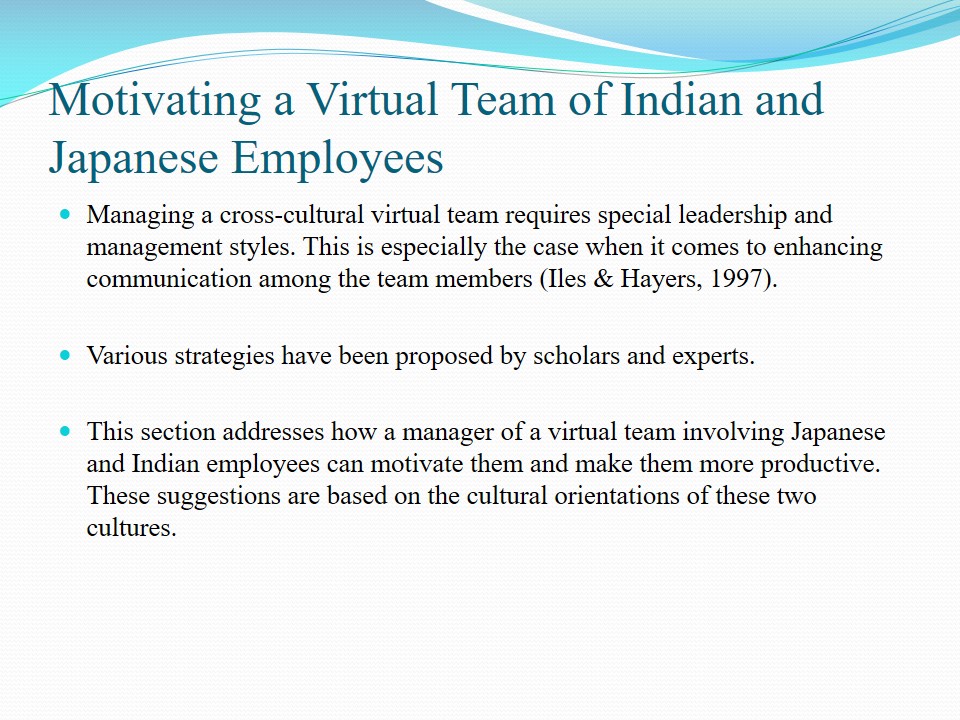
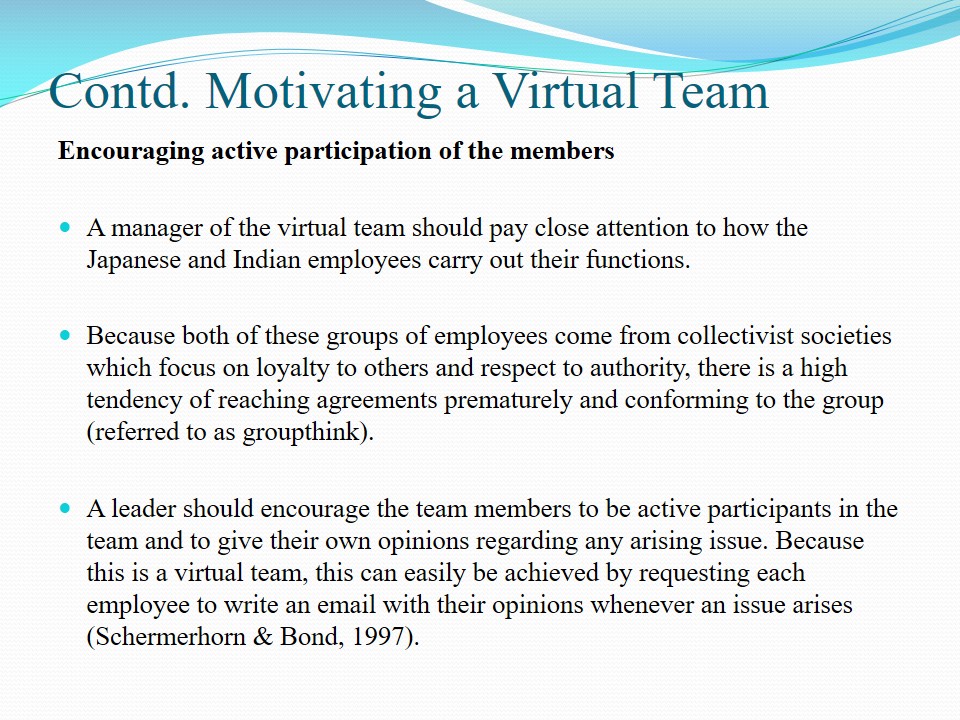
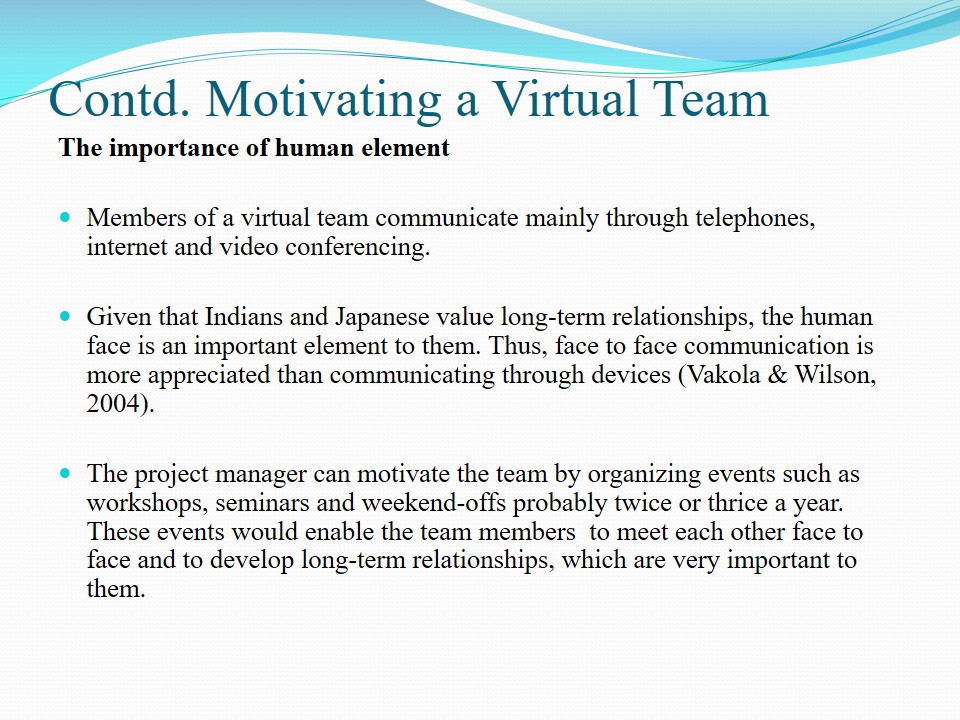
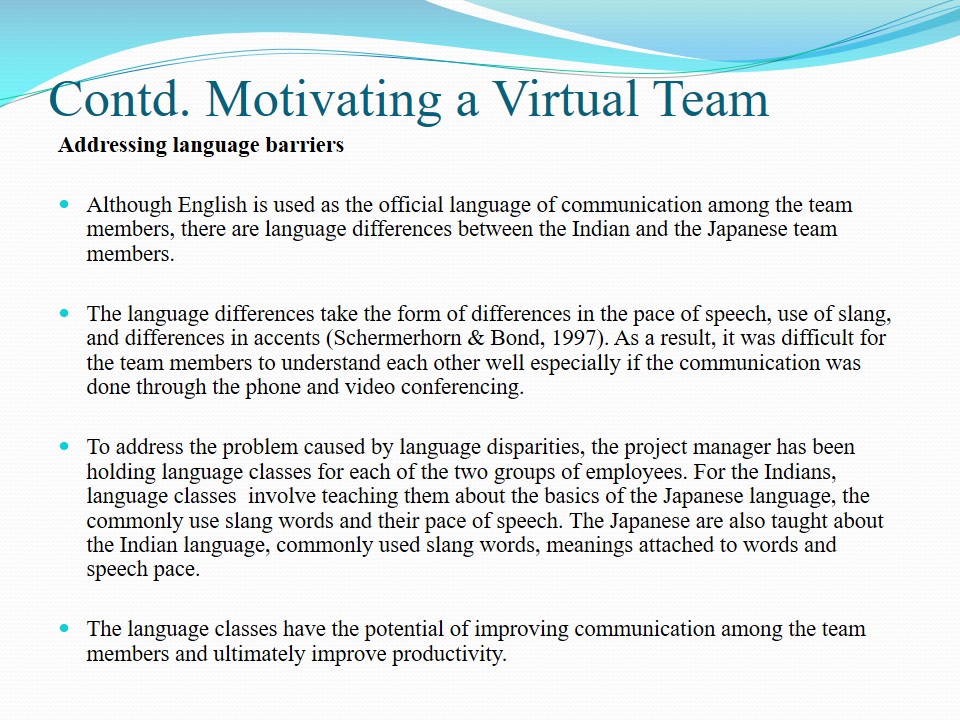
Conclusion
- The case study discussed in this presentation is on motivating a virtual team consisting of Indian and Japanese employees.
- Cultural differences as well as language differences between the two groups of employees can hinder the productivity and efficiency of the virtual team.
- The project manager can enhance productivity by addressing the culture-based barriers and motivating the virtual team members. Based on the cultural orientations and differences of Indians and Japanese, the case study proposes measures such as:
- encouraging active participation of team members;
- occasional face-to-face meetings so as to build long-term relationships;
- addressing language barriers through language classes.
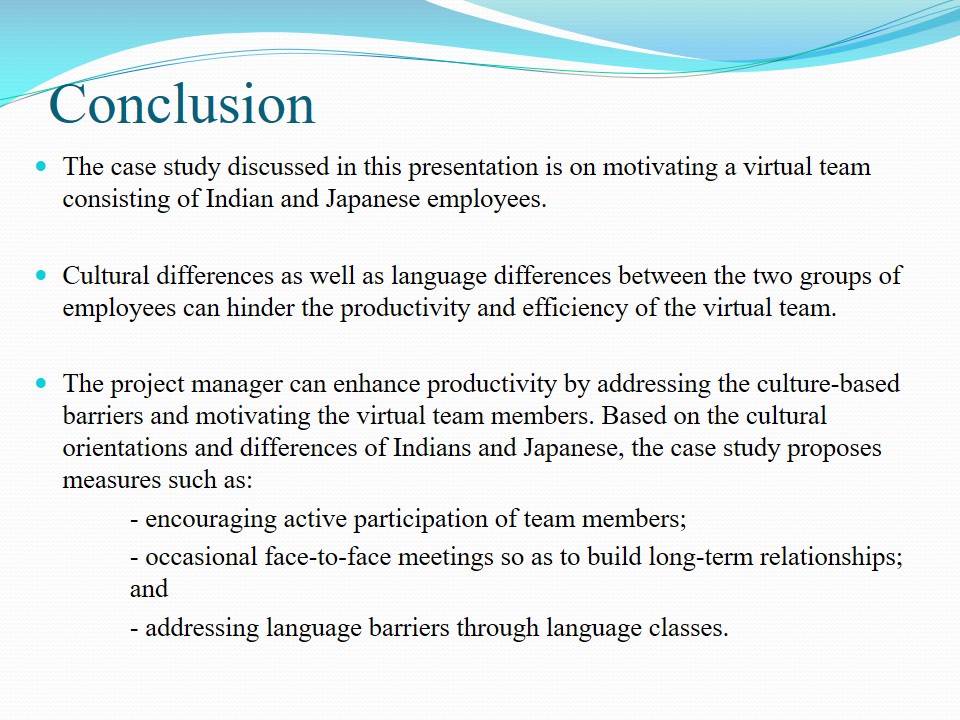
Reference List
- Bobby, V., & Yohannan, A. (1992). Cultural diversity and interpersonal communication skills: A study of Indian managers. Leadership & Organization Development, 13(7), 26-31.
- Dalton, M., Ernst, C., Leslie, J., & Deal, J. (2002). Effective global management: established constructs and novel contexts. European Journal of Work and Organizational Psychology, 11(4), 443-68.
- Ess, C. (2009). Digital Media Ethics. Cambridge: Polity Press.
- Fisher, A. (2001). Critical thinking: An introduction. Cambridge: Cambridge University Press.
- Gopalan, S., & Dixon, R. (1996). An exploratory investigation of organizational values in the United States and India. Journal of Transnational Management Development, 2(2), 87-111.
- Hinds, P.J., & Bailey, D.E. (2003). Out of sight, out of sync: understanding conflict in distributed teams. Organization Science, 14(6), 615-32.
- Iles, P., & Hayers, K.P. (1997). Managing diversity in transnational project teams. Journal of Managerial Psychology, 12(2), 95-117.
- Oertig, M., & Buergi, T. (2006). The challenges of managing cross-cultural virtual project teams. Team Performance Management, 12(1/2), 23-30.
- Schermerhorn, J.R., & Bond, M.H. (1997). Cross-cultural leadership dynamics in collectivism and high power distance settings. Leadership & Organization Development Journal, 18(4), 187.
- Sinha, J. B. P., &Sinha, D. (1994). Role of social values in Indian organizations. In Henry S. R. Kao, Durgan and Sinha, and Ng Sek-Hong (eds.), Effective Organizations and Social Values. New Delhi: Sage Publications, 164-173.
- Qingxue, L. (2003). Understanding different cultural patterns or orientations between East and West. Language Research, 9, 21-30.
- Vakola, M., & Wilson, I.E. (2004). The challenge of virtual organizations: critical success factors in dealing with constant change. Team Performance Management, 10(5/6), 112-20.